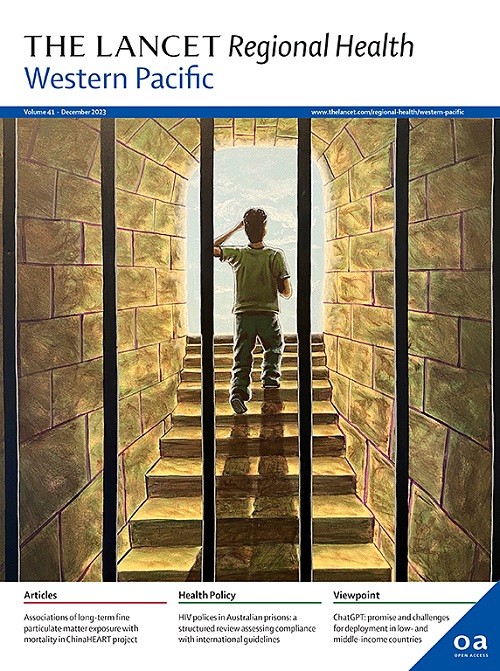Improvement of early gastric cancer detection via a serum-based sequential screening strategy (4S): a prospective large-scale nationwide study in China
IF 7.6
1区 医学
Q1 HEALTH CARE SCIENCES & SERVICES
引用次数: 0
Abstract
Background
Gastric cancer (GC) is one of the most important cancers that warrant screening. A sequential strategy incorporating risk stratification may identify the minority for further endoscopic examination, and biomarkers of gastric atrophy could serve as effective prescreening tools at a low cost. However, its feasibility and acceptability has yet to be fully validated in real-world settings, and in which scenarios a higher early cancer detection rate can be achieved remains unclear.
Methods
This multicenter population-based prospective study was conducted in 266 participating institutions throughout China, spanning sites of communities, hospital (outpatient clinics), and physical exam centers, from 2022 to 2024. Adults aged 40–80 years, with or without mild symptoms, meeting the criteria for being at risk of GC, were invited for serological risk evaluation by pepsinogen and gastrin-17 risk panel. Those identified as intermediate or high risk were subsequently recommended for gastroscopy, establishing the serum-based sequential screening strategy (4S) group. Meanwhile, consecutive endoscopic diagnoses were collected in a real-world clinical setting, set as the control group. The rate of gross screening positivity, endoscopic positivity, early cancer detection, and endoscopic compliance, were compared between the two groups, and among the three screening sites within the ‘4S’ group.
Findings
In the ‘4S' group, 106,088 participants underwent serological risk assessments and 33.0% (34,979/106,068) fell into the medium to high-risk cohort, of which 33.3% (11,660/34,979) invitees underwent gastroscopy as recommended. Meanwhile, 27,764 subjects were included in the control group. The gross screening positive rate in the ‘4S’ group achieved 3.0‰, and gastroscopy uptake increase with risk prescreening scores (OR = 3.96, P < 0.001). When compared to the control group, the implementation of '4S' screening significantly increased the endoscopic positivity rate (2.2% vs. 0.8%, P < 0.001), and doubled the rate of early cancer detection (62.3% vs. 26.9%, P < 0.001). Compared with screening in hospital setting, community-based screening and physical examinations demonstrated superior capacity to detect tumors at an early stage (77.8% and 77.1% vs. 55.0%, P = 0.008 and 0.002), even though more cases of GC were found in the hospital setting (2.6% vs. 0.9% in community and 1.6% in physical exam). Also, the physical exam showed a poor adherence to gastroscopy (20.5% vs. 41.0% in hospital and 32.2% in community). Community or hospital-based screening showed acceptable cost-effective results by health economic analysis.
Interpretation
‘4S’ strategy stands out as a practical and economical option in China, as well as in countries encountering similar high-risk GC population. Community screening is highly recommended to improve early GC detection. More healthcare education should be introduced to enhance compliance to gastroscopy.
通过基于血清的序贯筛查策略(4S)提高早期胃癌的检测:一项在中国进行的大规模前瞻性全国性研究
胃癌(GC)是最重要的需要筛查的癌症之一。纳入风险分层的顺序策略可以确定少数人进行进一步的内镜检查,胃萎缩的生物标志物可以作为低成本的有效预筛选工具。然而,其可行性和可接受性尚未在现实环境中得到充分验证,并且在哪些情况下可以实现更高的早期癌症检出率仍不清楚。方法该多中心人群前瞻性研究于2022年至2024年在中国266个参与机构进行,涵盖社区、医院(门诊)和体检中心。年龄在40-80岁之间,有或没有轻微症状,符合胃癌风险标准的成年人,接受胃蛋白酶原和胃泌素-17风险小组的血清学风险评估。那些被确定为中度或高风险的患者随后被推荐进行胃镜检查,建立了基于血清的顺序筛查策略(4S)组。同时,在真实的临床环境中收集连续的内镜诊断,作为对照组。比较两组及“4S”组内三个筛查部位的总筛查阳性率、内镜阳性率、早期癌症检出率和内镜依从性。在“4S”组中,106,088名参与者接受了血清学风险评估,33.0%(34,979/106,068)的参与者属于中高风险队列,其中33.3%(11,660/34,979)的参与者按照建议接受了胃镜检查。同时,将27764名受试者纳入对照组。“4S”组的总筛查阳性率达到3.0‰,胃镜检查使用率随风险预筛查评分的增加而增加(OR = 3.96, P <;0.001)。与对照组相比,实施“4S”筛查显著提高了内镜下阳性率(2.2% vs. 0.8%, P <;0.001),早期癌症检出率翻了一番(62.3% vs. 26.9%, P <;0.001)。与医院筛查相比,社区筛查和体检在早期发现肿瘤的能力更强(77.8%和77.1% vs. 55.0%, P = 0.008和0.002),尽管在医院中发现的GC病例更多(2.6% vs.社区筛查0.9%,体检1.6%)。此外,体检显示胃镜检查的依从性较差(20.5%,医院41.0%,社区32.2%)。通过卫生经济分析,以社区或医院为基础的筛查显示出可接受的成本效益结果。解读“4S”策略在中国以及遇到类似高危GC人群的国家是一种实用和经济的选择。强烈建议进行社区筛查,以提高早期GC检测。应加强健康教育,提高胃镜检查依从性。
本文章由计算机程序翻译,如有差异,请以英文原文为准。
求助全文
约1分钟内获得全文
求助全文
来源期刊

The Lancet Regional Health: Western Pacific
Medicine-Pediatrics, Perinatology and Child Health
CiteScore
8.80
自引率
2.80%
发文量
305
审稿时长
11 weeks
期刊介绍:
The Lancet Regional Health – Western Pacific, a gold open access journal, is an integral part of The Lancet's global initiative advocating for healthcare quality and access worldwide. It aims to advance clinical practice and health policy in the Western Pacific region, contributing to enhanced health outcomes. The journal publishes high-quality original research shedding light on clinical practice and health policy in the region. It also includes reviews, commentaries, and opinion pieces covering diverse regional health topics, such as infectious diseases, non-communicable diseases, child and adolescent health, maternal and reproductive health, aging health, mental health, the health workforce and systems, and health policy.
 求助内容:
求助内容: 应助结果提醒方式:
应助结果提醒方式:


